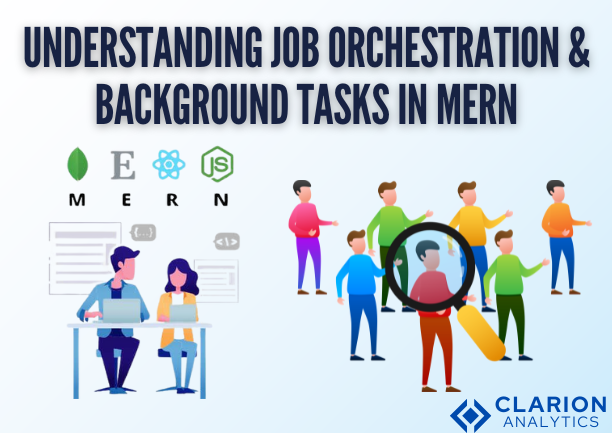
Modern web development requires more than request processing to achieve responsive scalable systems. Time-consuming tasks such as image processing or email sending or data analysis operations require too much server resource use when run on the main application thread. Job orchestration becomes essential in this point of the workflow.
A job orchestration system enables background task scheduling and management to let main applications achieve fast response levels. Job orchestration functions best in environments that combine MongoDB with Express.js and React and Node.js. This framework for Job orchestration is known as the MERN stack. The MERN stack enables JavaScript across the entire development process yet Node.js requires attention because its single-threaded model affects processing of heavy or extended operations.
This article demonstrates the implementation of Celery task queue system from Python world into MERN stack to optimize background processing while maintaining application speed and expandability.
1. Understanding Job Orchestration & Background Tasks in MERN
Job orchestration serves as the method to automatically schedule and run background procedures thus guaranteeing their execution at predefined moments while upholding specific task sequences and environment requirements. Background tasks are shifted to new processing systems through this technique to keep primary system operations uninterrupted.
Common Use Cases in MERN Applications for Job orchestration
MERN-based applications often require:
The application uses email functionalities such as automatic sending welcome messages and resetting passwords through email.
Image and video processing
API rate-limited tasks
Data crunching for analytics dashboards
Node.js performance may decrease due to direct execution of these demanding tasks inside the Node.js environment.
Limitations of Node.js for Heavy Workloads
The event loop in Node.js operates with one thread to get the best performance for I/O operations yet struggles with processes that demand extensive CPU utilization. Async operations provide benefits but they fail to remove completely the performance problems associated with resource-intensive tasks. The threading system and child_process system present in Node.js provide native solutions yet designing these approaches becomes challenging when working on extensive applications.
Alternative Task Queues in JavaScript
Task queues that operate on the Node platform consist of the following popular options:
BullMQ (Redis-based)
Agenda.js (MongoDB-based)
The task queue systems feature basic functionality while missing out on several advanced capabilities such as task retries and scheduling and result processing which Celery provides as a mature tool.
2. Why Use Celery for Background Task Management?
The essential aspects of job orchestration by Celery include
Celery presents itself as a production-grade distributed task queue system that developers write in Python. It offers:
Task distribution via multiple worker nodes
The system enables retry capabilities along with task scheduling and queuing routines.
Redis and RabbitMQ join a selection of different message brokers that Celery supports.
Task management systems use dashboards for the real-time monitoring of task status activities.
You can effortlessly move parallel processes from your main application to run horizontally with this platform.
How Celery Integrates with a MERN Stack
Through connection with Redis as a message broker Node.js can easily work alongside Python-based Celery. Here’s how:
The system contains Python microservice which operates Celery workers.
Node.js (Express API) delivers task payloads toward the Redis platform.
The Celery system retrieves the assigned task after which it starts execution while possibly generating output results.
The React frontend interacts with Express to perform task submits as well as check status requests.
Node.js utilizes this architecture to pass complex processes to the Python environment while retaining effective development processes.
3. Implementing Celery with a MERN Stack – Step-by-Step Guide
1. Setting up Redis as the Message Broker
First, install and run Redis on your server or use a cloud provider like Redis Cloud.
“`
sudo apt install redis
redis-server
“`
Ensure it’s accessible by both your Node.js API and the Celery microservice.
2. Implementing a Python Microservice with Celery
Install FastAPI, Celery, and dependencies:
“`
pip install fastapi uvicorn celery redis
“`
celery_app.py:
“`
from celery import Celery
app = Celery(‘tasks’, broker=’redis://localhost:6379/0′)
@app.task
def add(x, y):
return x + y
“`
Run the worker:
“`
celery -A celery_app worker –loglevel=info
“`
3. Connecting Node.js (Express API) to Celery
Use ioredis or bullmq in Node.js to publish tasks:
“`
const Redis = require(“ioredis”);
const redis = new Redis();
app.post(“/start-task”, async (req, res) => {
const taskData = JSON.stringify({ task: “add”, args: [4, 6] });
await redis.lpush(“celery”, taskData);
res.json({ status: “Task submitted” });
});
“`
Alternatively, use a REST endpoint in FastAPI to trigger Celery tasks.
4. Submitting Background Tasks from a React Frontend
A simple POST request from React can trigger a job:
“`
await fetch(“/start-task”, { method: “POST” });
“`
You can add task status polling or WebSocket-based updates for real-time UX.
5. Monitoring Tasks and Handling Results
Use Flower, a Celery monitoring tool:
“`
pip install flower
celery -A celery_app flower
“`
Conclusion
Integrating Celery into a MERN The execution of background processes through stack requires initial education but delivers effective and scalable management methods for automated work control. Node.js maintains the front-end operations alongside Python and Celery which perform resource-intensive workloads through their individual competence.
MERN applications combine these programming habits into a single operational approach which results in:
Offload resource-intensive work
Improve response times
Scale efficiently
Full-stack JavaScript developers should consider utilizing Redis as a message broker together with Flower for monitoring because these tools make Celery a champion solution for enhancing backend architecture and Job orchestration
Are you intrigued by the possibilities of AI? Let’s chat! We’d love to answer your questions and show you how AI can transform your industry. Contact Us
